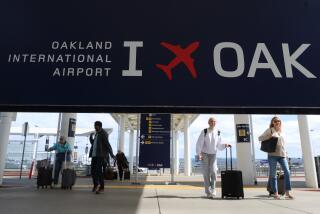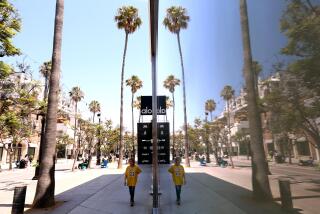Taking Flak : Historic Santa Monica Airport Still Fights Complaints Over Noise, Safety
Many of the people who live in the Westside neighborhoods that surround Santa Monica Airport are resigned to their fate. They may not like living with the airport, but they know itâs not going away any time soon.
Crashes such as two that occurred earlier this month--one single-engine Cessna fell into a busy Venice street, another into a country club golf course--serve as dramatic reminders of the hazards of life under the air lanes and renew cries among homeowners for better safety measures.
Sprawled over 215 acres of some very expensive land a short distance from the beach, one of the oldest airports in California started as a dirt strip in a barley field in 1919 and grew as home to the Douglas Aircraft Co. during World War II. Howard Hughes and Hal Roach used to tie down there; the DC-3 was built there, and the first round-the-world flight, orchestrated by Douglas, took off from Santa Monica Airport.
Basis of Complaints
Its critics--some of whom are neighboring homeowners who fought unsuccessfully for years to close the airport--contend that as Los Angeles has grown, the general aviation facility is no longer suitable for its location. With an average of nearly 500 landings and takeoffs a day, the airport has no business sitting in the middle of the densely populated, largely upscale Westside, serving one of the most traveled air corridors in the world, say these critics.
âIt might have made sense 40 years ago, when there were orange groves and bean fields out there. But it certainly makes no sense today,â said Bill Rosendahl, an executive with a cable television company who lives in Venice, about two miles from the airport.
âThis is Santa Monica. Venice. Marina del Rey,â he continued. âPeople are paying some of the highest real estate (prices) in the nation. We want to be close to the beach and have clean air and quality of life. We donât want noise pollution and safety problems.â
Similar arguments are repeated by homeowners near airports the world over, but in few places is the land in question as pricey and ripe for development as on Los Angelesâ Westside.
Users and supporters of the airport counter: The airportâs choice location--a short jog from Century City law offices, Malibu mansions and Beverly Hills banks--is precisely part of what makes the facility so attractive.
âYou can come in from New York, you rent a car, or your limousine is here waiting for you, and youâre just minutes from where you have to go,â said Stephen Dennis, president of Gunnell Aviation, one of the principal fixed-based operators at the airport.
And airport officials say the one-runway facility has chalked up an excellent safety record, plays a crucial role in relieving congestion at Los Angeles International Airport, and uses innovative noise-reduction systems. Just last weekend, the airport banned two jets for being too loud.
The airport, located in the far southeast corner of Santa Monica bordering several Los Angeles neighborhoods, is today used primarily by small private planes, executive jets, news helicopters, movie-location spotters and student pilots.
Safety and aircraft noise are only two of the issues dogging Santa Monica officials these days when it comes to the airport property.
In an effort to make the airport âcommunity friendly,â an aviation museum, an administration building with observation decks and an expensive trendy restaurant have opened in sleek headquarters on the airport grounds.
But Santa Monicaâs plan to build a huge office complex on the vacated southern land has set the stage for yet another battle: Homeowner groups say that while they may be forced to put up with the airport, they wonât stand for the large-scale development that Santa Monica officials envision. And the homeowners have backing from top Los Angeles officials.
The way one story goes, in 1919, World War I Air Force Maj. Corliss Champion Moseley was scouting for a new location for his California National Guard Air Squadron, having been evicted from Griffith Park.
He flew all over Southern California in a Curtiss biplane looking for a place; the spot he liked best was a piece of farmland in Santa Monica.
The city of Santa Monica authorized the leasing of 15 acres to establish a small aviation field in December, 1919. (Later, the city would purchase the land.) It was dedicated in 1923 as Clover Field, named for World War I pilot Lt. Greayer (Grubby) Clover.
In addition to training war pilots, the airdrome, as it was called, was used by motion picture stunt pilots and barnstormers. It was an era when numerous small airfields dotted the meadows that would become Los Angeles County. Only Santa Monica and a couple others survived.
In the â20s, the field began to expand around Douglas Aircraft, founded by Donald W. Douglas, one of the countryâs most important aviation pioneers. More growth came during World War II, when Douglas Aircraft churned out thousands of bombers and transport carriers.
When the airfield was first established, the area was sparsely populated. But by 1940, when Douglas and the airport began growing, city records and old news reports show that 46 residential tracts had to be condemned and vacated to make way for the expansion. And an 18-hole golf course gave way to longer runways.
And at about the same time, legal battles--which would span decades--began.
Lawsuits From All
Residents sued the city to close the airport, to ban jets and to demand compensation for alleged declines in their property values. Pilots also started suing, saying the city was exceeding its power in trying to impose restrictions on air traffic.
The furor reached a crescendo in the late 1970s and early â80s. In June, 1981, a newly elected liberal City Council voted to close the airport. Almost immediately, however, the U.S. Justice Department announced it would take Santa Monica to court for violating federal contracts in operation of the airport.
After several years of intense negotiation, an agreement was signed in 1984. To appease the pilots and the Federal Aviation Administration, Santa Monica would keep the airport open until at least 2015; to appease the homeowners, Santa Monica would consolidate airport facilities to the north side of the property and enforce laws to keep the noise down.
It is unclear what will happen after the year 2015.
While the fights raged over the airport, the character of the surrounding neighborhoods was changing steadily and dramatically.
Many of the neighborhoods had sprouted because of Douglas Aircraft. Santa Monicaâs Sunset Park, Los Angelesâ Mar Vista, sections of Venice--rows of working-class housing tracts of mechanics and assembly-line parts-manufacturers. In 1962, Douglas left the Santa Monica site because the city refused to allow it to take over additional residential property for expansion.
New People Move In
New people began to move into the neighborhoods who bore no loyalty to Douglas and who saw no reason to tolerate airport noise. Their discontent--and the arrival of louder jets--fueled the waves of airport opposition in the 1970s.
And now, an evolution of sorts is again under way.
As real estate prices on the Westside soar, many of the people who bought their houses 20 or 30 years ago are cashing in, selling to younger, more affluent professionals. The signs are everywhere: for sale placards on every other block, houses undergoing major renovations.
Some of the residents hate the airport. Others find it picturesque. Mostly, there is an air of frustrated resignation.
âItâs a combination of giving up, and of adjusting your ears and life style,â said Denise DuBroy, an artist who, with her husband, bought a home one block from the western tip of the runway three years ago.
DuBroy, who once served on the cityâs airport commission, said she keeps the television remote control handy to raise the volume each time a plane flies overhead, and she used double-pane glass for an addition to the dining room. There is little out-of-doors entertaining, and people learn to pause in conversation each time a plane passes above.
Much more bitter are some residents in neighboring Venice, who claim they get the brunt of the noise.
Thomas Kirwan, 63, a retired aerospace engineer, has fought the airport for more than 20 years. He is one of 50 Los Angeles homeowners who still have a lawsuit pending. A pretrial hearing is set for September. âIâm determined to get rid of that airport,â he said.
Response to Crashes
In the wake of the two crashes earlier this month, a group of Venice residents called for a moratorium on student training flights. Los Angeles City Councilwoman Ruth Galanter, whose office says the airport is a âconstantâ source of complaints, went further, asking the FAA to kick flying schools out of the Santa Monica Airport and put a limit on the number of flights.
Supporters of the airport say such responses are an overreaction. The crashes, they point out, were caused by mechanical failure, not student errors.
The airport does have supporters among its neighbors. Venice resident Marylee Westbrook says she chose the location precisely because of the airport and has just invested $250,000 to renovate the home she has owned for 10 years on Rose Avenue, next to the Penmar golf course under the takeoff path.
âIt (the airport) adds such charm to the neighborhood,â Westbrook, 41, said. âIt makes you think of bygone days. Something special. Something exotic.â
The city has placed four microphones atop telephone poles around the airport to monitor noise and issues a citation any time a jetâs takeoff noise exceeds the 95-decibel level, Airport Director Hank Dittmar said. The allowable level is being reduced gradually.
Dittmar also enforces a ban on takeoffs and landings after 11 p.m. and before 7 a.m. Complaints about noise are one-tenth what they were five years ago, he said. There were 17 in June.
âWe are making it the quietest airport in Southern California,â said Dittmar, 33. âAnd we are trying to integrate it into the community and not have the airport as just an aviatorâs country club.â
Traffic Declines
Traffic at the airport, which pays for itself and adds about $200,000 a year to the city treasury, has declined steadily over the years, from about 350,000 takeoffs and landings a year in the 70s to 175,000 last year, Dittmar said.
Meanwhile, a new and equally controversial chapter in the airportâs history is unfolding.
The terminal and administration offices, as well as one of the fixed-based operators, have moved into new $27-million buildings on the north side of the airport, complete with a vintage aircraft museum, artsy sculptures and the highly touted DC-3 Restaurant.
On 37 acres of land on the south side of the airport, the city wants to construct a sprawling $300-million office complex with movie studios. Early designs by Reliance Development Group, the developer chosen by the city, suggest a 1.4-million-square-foot project of nine buildings four to six stories high, which would earn millions for Santa Monica.
Already, several homeowner groups, Los Angeles Mayor Tom Bradley and other Los Angeles officials have suggested they will take Santa Monica to court to stop or significantly reduce the project, which they claim would propel thousands of cars into Los Angeles neighborhoods.
More to Read
Sign up for Essential California
The most important California stories and recommendations in your inbox every morning.
You may occasionally receive promotional content from the Los Angeles Times.











